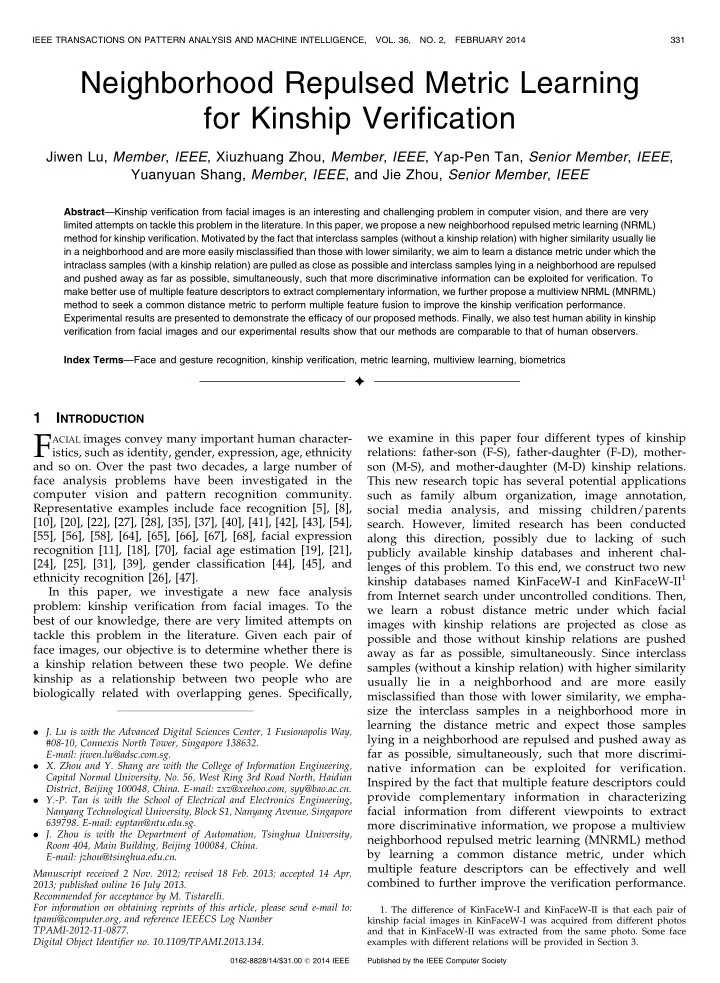

IEEE TRANSACTIONS ON PATTERN ANALYSIS AND MACHINE INTELLIGENCE, VOL. 36, NO. 2, FEBRUARY 2014 331 Neighborhood Repulsed Metric Learning for Kinship Verification Jiwen Lu, Member , IEEE , Xiuzhuang Zhou, Member , IEEE , Yap-Pen Tan, Senior Member , IEEE , Yuanyuan Shang, Member , IEEE , and Jie Zhou, Senior Member , IEEE Abstract —Kinship verification from facial images is an interesting and challenging problem in computer vision, and there are very limited attempts on tackle this problem in the literature. In this paper, we propose a new neighborhood repulsed metric learning (NRML) method for kinship verification. Motivated by the fact that interclass samples (without a kinship relation) with higher similarity usually lie in a neighborhood and are more easily misclassified than those with lower similarity, we aim to learn a distance metric under which the intraclass samples (with a kinship relation) are pulled as close as possible and interclass samples lying in a neighborhood are repulsed and pushed away as far as possible, simultaneously, such that more discriminative information can be exploited for verification. To make better use of multiple feature descriptors to extract complementary information, we further propose a multiview NRML (MNRML) method to seek a common distance metric to perform multiple feature fusion to improve the kinship verification performance. Experimental results are presented to demonstrate the efficacy of our proposed methods. Finally, we also test human ability in kinship verification from facial images and our experimental results show that our methods are comparable to that of human observers. Index Terms —Face and gesture recognition, kinship verification, metric learning, multiview learning, biometrics Ç 1 I NTRODUCTION F ACIAL images convey many important human character- we examine in this paper four different types of kinship istics, such as identity, gender, expression, age, ethnicity relations: father-son (F-S), father-daughter (F-D), mother- and so on. Over the past two decades, a large number of son (M-S), and mother-daughter (M-D) kinship relations. face analysis problems have been investigated in the This new research topic has several potential applications computer vision and pattern recognition community. such as family album organization, image annotation, Representative examples include face recognition [5], [8], social media analysis, and missing children/parents [10], [20], [22], [27], [28], [35], [37], [40], [41], [42], [43], [54], search. However, limited research has been conducted [55], [56], [58], [64], [65], [66], [67], [68], facial expression along this direction, possibly due to lacking of such recognition [11], [18], [70], facial age estimation [19], [21], publicly available kinship databases and inherent chal- [24], [25], [31], [39], gender classification [44], [45], and lenges of this problem. To this end, we construct two new ethnicity recognition [26], [47]. kinship databases named KinFaceW-I and KinFaceW-II 1 In this paper, we investigate a new face analysis from Internet search under uncontrolled conditions. Then, problem: kinship verification from facial images. To the we learn a robust distance metric under which facial best of our knowledge, there are very limited attempts on images with kinship relations are projected as close as tackle this problem in the literature. Given each pair of possible and those without kinship relations are pushed face images, our objective is to determine whether there is away as far as possible, simultaneously. Since interclass a kinship relation between these two people. We define samples (without a kinship relation) with higher similarity kinship as a relationship between two people who are usually lie in a neighborhood and are more easily biologically related with overlapping genes. Specifically, misclassified than those with lower similarity, we empha- size the interclass samples in a neighborhood more in learning the distance metric and expect those samples . J. Lu is with the Advanced Digital Sciences Center, 1 Fusionopolis Way, lying in a neighborhood are repulsed and pushed away as #08-10, Connexis North Tower, Singapore 138632. far as possible, simultaneously, such that more discrimi- E-mail: jiwen.lu@adsc.com.sg. . X. Zhou and Y. Shang are with the College of Information Engineering, native information can be exploited for verification. Capital Normal University, No. 56, West Ring 3rd Road North, Haidian Inspired by the fact that multiple feature descriptors could District, Beijing 100048, China. E-mail: zxz@xeehoo.com, syy@bao.ac.cn. provide complementary information in characterizing . Y.-P. Tan is with the School of Electrical and Electronics Engineering, facial information from different viewpoints to extract Nanyang Technological University, Block S1, Nanyang Avenue, Singapore 639798. E-mail: eyptan@ntu.edu.sg. more discriminative information, we propose a multiview . J. Zhou is with the Department of Automation, Tsinghua University, neighborhood repulsed metric learning (MNRML) method Room 404, Main Building, Beijing 100084, China. by learning a common distance metric, under which E-mail: jzhou@tsinghua.edu.cn. multiple feature descriptors can be effectively and well Manuscript received 2 Nov. 2012; revised 18 Feb. 2013; accepted 14 Apr. combined to further improve the verification performance. 2013; published online 16 July 2013. Recommended for acceptance by M. Tistarelli. For information on obtaining reprints of this article, please send e-mail to: 1. The difference of KinFaceW-I and KinFaceW-II is that each pair of tpami@computer.org, and reference IEEECS Log Number kinship facial images in KinFaceW-I was acquired from different photos TPAMI-2012-11-0877. and that in KinFaceW-II was extracted from the same photo. Some face Digital Object Identifier no. 10.1109/TPAMI.2013.134. examples with different relations will be provided in Section 3. 0162-8828/14/$31.00 � 2014 IEEE Published by the IEEE Computer Society
Recommend
More recommend